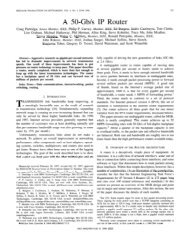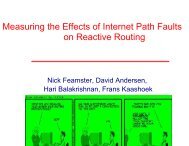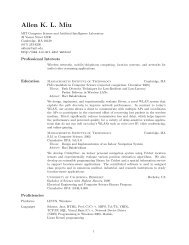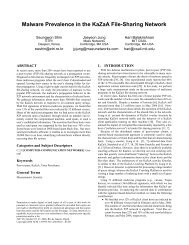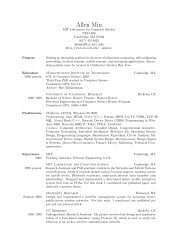Chord - Networks and Mobile Systems - MIT
Chord - Networks and Mobile Systems - MIT
Chord - Networks and Mobile Systems - MIT
Create successful ePaper yourself
Turn your PDF publications into a flip-book with our unique Google optimized e-Paper software.
When consistent hashing is implemented as described above, the<br />
theorem proves a bound of £¥¤§¦©¨<br />
¢ . The consistent hashing<br />
<br />
paper shows that can be reduced to an arbitrarily small constant<br />
by having each node run £¥¤§¦©¨<br />
“virtual nodes” each with its<br />
¢<br />
own identifier.<br />
The phrase “with high probability” bears some discussion. A<br />
simple interpretation is that the nodes <strong>and</strong> keys are r<strong>and</strong>omly chosen,<br />
which is plausible in a non-adversarial model of the world.<br />
The probability distribution is then over r<strong>and</strong>om choices of keys<br />
<strong>and</strong> nodes, <strong>and</strong> says that such a r<strong>and</strong>om choice is unlikely to produce<br />
an unbalanced distribution. One might worry, however, about<br />
an adversary who intentionally chooses keys to all hash to the same<br />
identifier, destroying the load balancing property. The consistent<br />
hashing paper uses “ -universal hash functions” to provide certain<br />
guarantees even in the case of nonr<strong>and</strong>om keys.<br />
Rather than using a -universal hash function, we chose to use<br />
the st<strong>and</strong>ard SHA-1 function as our base hash function. This makes<br />
our protocol deterministic, so that the claims of “high probability”<br />
no longer make sense. However, producing a set of keys that collide<br />
under SHA-1 can be seen, in some sense, as inverting, or “decrypting”<br />
the SHA-1 function. This is believed to be hard to do. Thus,<br />
instead of stating that our theorems hold with high probability, we<br />
can claim that they hold “based on st<strong>and</strong>ard hardness assumptions.”<br />
For simplicity (primarily of presentation), we dispense with the<br />
use of virtual nodes. In this case, the load on a node may exceed the<br />
average by (at most) an £¥¤§¦©¨<br />
factor with high probability (or<br />
¢<br />
in our case, based on st<strong>and</strong>ard hardness assumptions). One reason<br />
to avoid virtual nodes is that the number needed is determined by<br />
the number of nodes in the system, which may be difficult to determine.<br />
Of course, one may choose to use an a priori upper bound on<br />
the number of nodes in the system; for example, we could postulate<br />
at most one <strong>Chord</strong> server per IPv4 address. In this case running 32<br />
virtual nodes per physical node would provide good load balance.<br />
4.3 Scalable Key Location<br />
A very small amount of routing information suffices to implement<br />
consistent hashing in a distributed environment. Each node<br />
need only be aware of its successor node on the circle. Queries<br />
for a given identifier can be passed around the circle via these successor<br />
pointers until they first encounter a node that succeeds the<br />
identifier; this is the node the query maps to. A portion of the <strong>Chord</strong><br />
protocol maintains these successor pointers, thus ensuring that all<br />
lookups are resolved correctly. However, this resolution scheme is<br />
inefficient: it may require traversing ¢ all nodes to find the appropriate<br />
mapping. To accelerate this process, <strong>Chord</strong> maintains<br />
additional routing information. This additional information is not<br />
essential for correctness, which is achieved as long as the successor<br />
information is maintained correctly.<br />
As before, let be the number of bits in the key/node identifiers.<br />
Each node, , maintains a routing table with (at most) entries,<br />
called the finger table. § The entry in the table at node contains<br />
the identity of the first node, , that succeeds by at least on<br />
the identifier circle, § i.e., , where <br />
(<strong>and</strong> all arithmetic is modulo ). We call node the §<br />
<br />
finger of node , <strong>and</strong> denote it finger § by node (see Table 1).<br />
A finger table entry includes both the <strong>Chord</strong> identifier <strong>and</strong> the IP<br />
address (<strong>and</strong> port number) of the relevant node. Note that the first<br />
finger of is its immediate successor on the circle; for convenience<br />
we often refer to it as the successor rather than the first finger.<br />
In the example shown in Figure 3(b), the finger table of node <br />
points to the successor nodes of identifiers ¤<br />
mod ,<br />
¤<br />
<br />
mod , <strong>and</strong> ¤<br />
mod <br />
<br />
, respectively.<br />
<br />
The successor of identifier is node , as this is the first node that<br />
<br />
<br />
<br />
¤<br />
<br />
<br />
Notation Definition<br />
finger <br />
¤<br />
<br />
<br />
mod , <br />
interval finger start finger <br />
<br />
<br />
<br />
start <br />
first node finger start<br />
<br />
successor the next node on the identifier circle;<br />
predecessor the previous node on the identifier circle<br />
finger<br />
<br />
node<br />
Table 1: Definition of variables for node , using -bit identifiers.<br />
follows , the successor of identifier is (trivially) node , <strong>and</strong> the<br />
successor of is node .<br />
This scheme has two important characteristics. First, each node<br />
stores information about only a small number of other nodes, <strong>and</strong><br />
knows more about nodes closely following it on the identifier circle<br />
than about nodes farther away. Second, a node’s finger table generally<br />
does not contain enough information to determine the successor<br />
of an arbitrary key . For example, node 3 in Figure 3 does not<br />
know the successor of 1, as ’s successor (node 1) does not appear<br />
in node ’s finger table.<br />
What happens when a node does not know the successor of a<br />
key ? If can find a node whose ID is closer than its own to ,<br />
that node will know more about the identifier circle in the region<br />
of than does. Thus searches its finger table for the node <br />
whose ID most immediately precedes , <strong>and</strong> asks for the node it<br />
knows whose ID is closest to . By repeating this process, learns<br />
about nodes with IDs closer <strong>and</strong> closer to .<br />
The pseudocode that implements the search process is shown in<br />
Figure 4. The notation n.foo() st<strong>and</strong>s for the function foo() being<br />
invoked at <strong>and</strong> executed on node . Remote calls <strong>and</strong> variable<br />
references are preceded by the remote node identifier, while local<br />
variable references <strong>and</strong> procedure calls omit the local node. Thus,<br />
n.foo() denotes a remote procedure call on node , n.bar, without<br />
parentheses, is an RPC to lookup a variable bar on node , while<br />
foo() denotes a local function call.<br />
find successor works by finding the immediate predecessor node<br />
of the desired identifier; the successor of that node must be the<br />
successor of the identifier. We implement find predecessor explicitly,<br />
because it is used later to implement the join operation (Section<br />
4.4).<br />
When node executes find predecessor, it contacts a series of<br />
nodes moving forward around the <strong>Chord</strong> circle towards . If node<br />
contacts a node such that falls between <strong>and</strong> the successor<br />
of , find predecessor is done <strong>and</strong> returns . Otherwise node<br />
asks for the node knows about that most closely precedes .<br />
Thus the algorithm always makes progress towards the precedessor<br />
of .<br />
As an example, consider the <strong>Chord</strong> ring in Figure 3(b). Suppose<br />
node wants to find the successor of identifier . Since belongs<br />
to the circular interval , it belongs finger to interval; node<br />
therefore checks the third entry in its finger table, which is .<br />
<br />
Because precedes , node will ask node to find the successor<br />
of . In turn, node will infer from its finger table that ’s successor<br />
is the node <br />
itself, <strong>and</strong> return node 1 to node 3.<br />
The finger pointers at repeatedly doubling distances around the<br />
circle cause each iteration of the loop in find predecessor to halve<br />
the distance to the target identifier. From this intuition follows a<br />
theorem:<br />
THEOREM 2. With high probability (or under st<strong>and</strong>ard hardness<br />
assumptions), the number of nodes that must be contacted to




